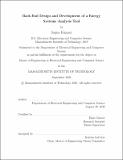| dc.contributor.advisor | Emre Gencer. | en_US |
| dc.contributor.author | Kumari, Sapna,M. Eng.Massachusetts Institute of Technology. | en_US |
| dc.contributor.other | Massachusetts Institute of Technology. Department of Electrical Engineering and Computer Science. | en_US |
| dc.date.accessioned | 2021-01-06T18:32:17Z | |
| dc.date.available | 2021-01-06T18:32:17Z | |
| dc.date.copyright | 2020 | en_US |
| dc.date.issued | 2020 | en_US |
| dc.identifier.uri | https://hdl.handle.net/1721.1/129165 | |
| dc.description | Thesis: M. Eng., Massachusetts Institute of Technology, Department of Electrical Engineering and Computer Science, September, 2020 | en_US |
| dc.description | Cataloged from student-submitted PDF of thesis. | en_US |
| dc.description | Includes bibliographical references (page 42). | en_US |
| dc.description.abstract | Sustainable Energy System Analysis Modeling Environment (SESAME) is a modular analytic environment designed for supporting various pathway-level and system-level analyses [1]. Pathway, in this context, refers to life cycle stages of a particular product from raw material extraction to production to its final end use. Pathway-level analysis include two main analysis types i.e Life Cycle Assessment(LCA) and Techno-Economic Assessment (TEA). LCA analysis calculates greenhouse gas (GHG) emissions associated with each of the various life cycle stages whereas TEA analysis calculates combined costs associated with the product or process through its life cycle. The high-level goal of the framework is to allow users to assess the sensitivity of key technological, operational and geographical parameters associated with various energy pathways as measured by the GHG emissions (through LCA) and techno-economic costs (through TEA). In this thesis, we present the back-end design and implementation of the SESAME web application that allows users to conduct pathway-level analyses for various energy pathways. The key contribution of our web-based framework is that it supports easy integration of new LCA and/or TEA models and data sources in the backend so they can be made easily available to users for analysis via the front-end web interface. We achieve this by creating a Python-based library of classes and functions that model a higher-level code-based representation of LCA and TEA pathways. Our tool is designed to capture the inherent modularity of SESAME, which again makes it easier for people who wish to add either new pathways or new data models and sources for existing pathways to our platform. | en_US |
| dc.description.statementofresponsibility | by Sapna Kumari. | en_US |
| dc.format.extent | 42 pages | en_US |
| dc.language.iso | eng | en_US |
| dc.publisher | Massachusetts Institute of Technology | en_US |
| dc.rights | MIT theses may be protected by copyright. Please reuse MIT thesis content according to the MIT Libraries Permissions Policy, which is available through the URL provided. | en_US |
| dc.rights.uri | http://dspace.mit.edu/handle/1721.1/7582 | en_US |
| dc.subject | Electrical Engineering and Computer Science. | en_US |
| dc.title | Back-end design and development of a energy systems analysis tool | en_US |
| dc.type | Thesis | en_US |
| dc.description.degree | M. Eng. | en_US |
| dc.contributor.department | Massachusetts Institute of Technology. Department of Electrical Engineering and Computer Science | en_US |
| dc.identifier.oclc | 1227276346 | en_US |
| dc.description.collection | M.Eng. Massachusetts Institute of Technology, Department of Electrical Engineering and Computer Science | en_US |
| dspace.imported | 2021-01-06T18:32:15Z | en_US |
| mit.thesis.degree | Master | en_US |
| mit.thesis.department | EECS | en_US |
